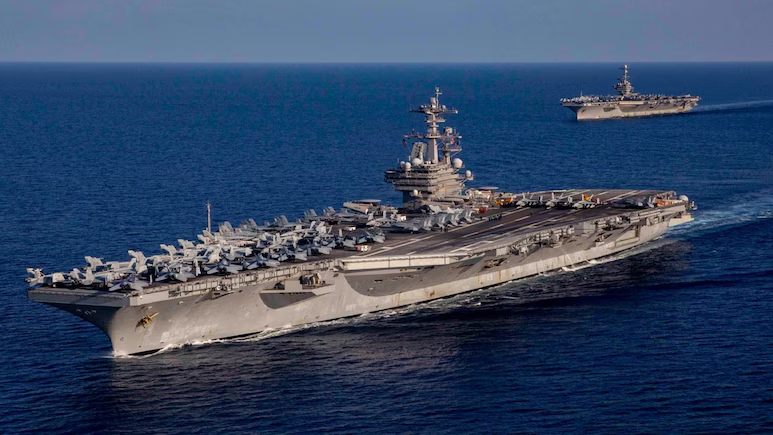USS Truman and Vinson Deployed as Trump Intensifies Pressure on Iran Ahead of Nuclear Talks

Trump Sends USS Truman and Vinson to Middle East to Pressure Iran
In a major military move, the United States has sent two powerful aircraft carriers—the USS Harry S. Truman and the USS Carl Vinson—to the Middle East. This action aligns with Donald Trump’s strategy to increase pressure on Iran over its nuclear program and regional activities.
Dual Carrier Deployment Shows Strength
The USS Harry S. Truman, stationed in the Red Sea, received extended deployment orders. The USS Carl Vinson is now heading toward the same region after finishing its mission in the Indo-Pacific. This marks a rare event. The U.S. hasn’t deployed two carriers to this area since 2020.
The move sends a strong signal. Washington wants to show Iran and its allies in the Gulf that it’s ready to act.
Trump’s Hardline Approach to Iran
Trump supports a strict policy on Iran. He demands tighter controls on uranium enrichment and calls for a complete halt beyond 3.67%. He also wants stronger international inspections and limits on Iran’s missile program.
His team believes showing military strength will force Iran to return to the negotiating table under new terms. Trump’s allies say this combination of military pressure and diplomacy will deliver better results than the 2015 deal.
Securing the Red Sea from Houthi Attacks
The deployment comes after a spike in attacks by Houthi rebels in Yemen. These rebels, supported by Iran, have targeted commercial ships in the Red Sea and Gulf of Aden. These waters are vital for global trade and oil transportation.
In response, the U.S. launched airstrikes on Houthi command centers and weapon depots. American officials say these strikes aim to cut off the rebels’ ability to launch attacks and receive supplies from Iran.
By placing two carriers in the area, the U.S. Navy can now conduct round-the-clock surveillance and strike operations if needed.
Diplomatic Talks Continue, But Tensions Rise
Even with the rising military presence, U.S. diplomats are still working to revive nuclear talks with Iran. Meetings in Vienna aim to prevent further escalation and find a peaceful solution.
But tensions remain high. Iran accuses the U.S. of using force to influence negotiations. U.S. officials, on the other hand, say Iran’s ongoing enrichment leaves little room for trust.
Analysts warn that time is running out. If Iran refuses to comply, the U.S. may respond with more sanctions or military action.
Gulf Nations Back U.S. Strategy
Countries like Saudi Arabia, the UAE, and Bahrain have welcomed the U.S. deployment. They see it as a clear message to Iran and a step toward securing the region.
Gulf leaders have long pushed for more U.S. support against Iranian influence. With two carrier strike groups in place, they now feel more confident about regional stability.
However, some European leaders and rights groups are concerned. They warn that the move could spark further conflict if not handled carefully.
Vinson and Truman Bring Firepower and Flexibility
The USS Carl Vinson carries advanced F/A-18 fighter jets, radar systems, and surveillance drones. It also sails with ships designed for submarine and air defense. The USS Truman brings similar tools to the mission.
Together, these two carriers can cover a vast area—from the Gulf of Aden to the Strait of Hormuz. They provide air support, launch quick strikes, and monitor threats at sea.
This deployment gives the U.S. Navy strong options for any situation that may arise in the region.
Mixed Opinions in Washington
Lawmakers in Washington have offered mixed reactions. Republicans have praised the move, calling it a return to strength. They say it reflects Trump’s commitment to protect U.S. interests.
Some Democrats worry about the risks. They fear the U.S. could be drawn into another long conflict. “We need a clear strategy, not just more ships,” said Senator Chris Murphy.
Americans Wary of Another Middle East Conflict
Among the public, opinions are also divided. Some support a firm stance on Iran. Others worry about potential war and the cost of extended military missions.
Military analysts agree that this is a critical moment. They say the U.S. must balance pressure with diplomacy to avoid a wider conflict.
What Comes Next?
The next few weeks are crucial. As the USS Truman and Vinson operate together, Iran will watch closely. The U.S. hopes the show of force will push Tehran to return to talks.
But if Iran retaliates or negotiations fail, the chance of a larger confrontation grows. Trump’s strategy aims to corner Iran into a deal—but the risks remain high.






